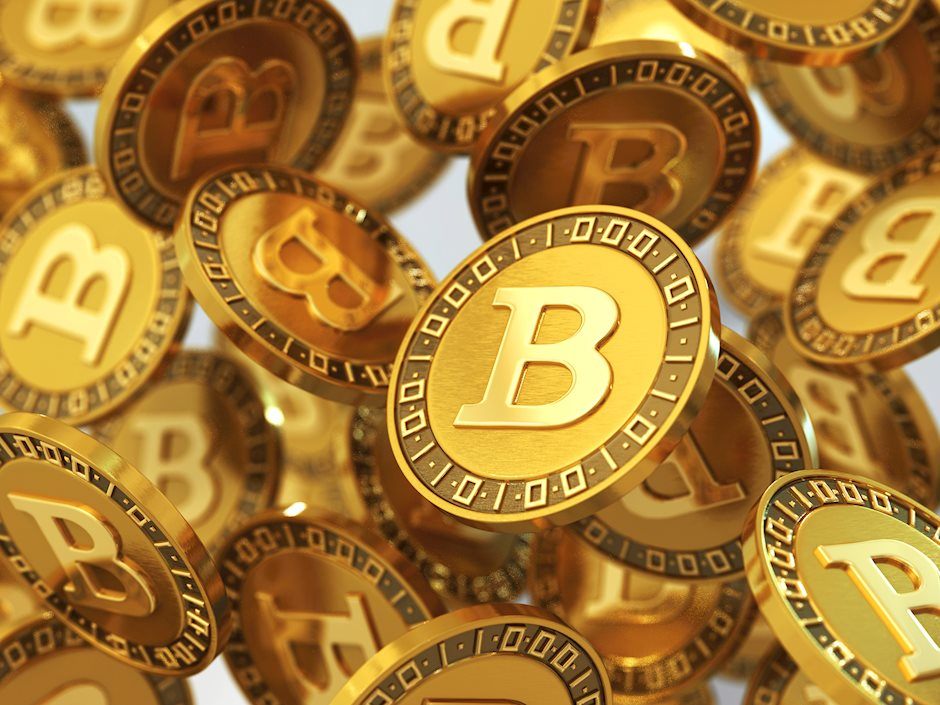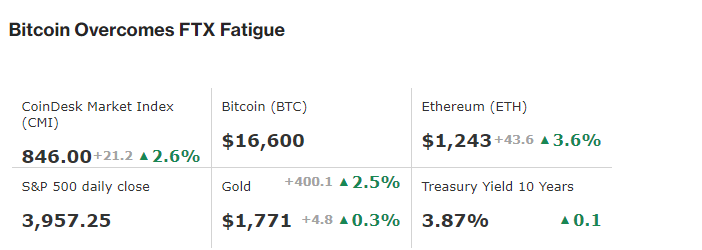First Mover Asia: Bitcoin, Ether rise late despite FTX fatigue

ALSO: Sam Reynolds considers the advantages of licensed custodians as the crypto industry wrestles with the fallout from crypto exchange FTX's implosion.
Good morning. Here’s what’s happening:
Prices: Bitcoin, ether and other major cryptocurrencies surge late to ride into the green.
Insights: Could licensed custodians help the crypto industry save itself?
Prices
By James Rubin
Battered but unbowed by FTX fallout, bitcoin rose late Monday from the depths of red to regain its foothold snugly above $16,000.
The largest cryptocurrency by market capitalization was recently holding steady at about $16,600, up nearly 2% over the past 24 hours, even as crypto market observers believe that it could dip to lower levels. Earlier in the day, BTC had dipped to about $15,850, below its most recent support.
“We have seen broader market instability despite some positive macro developments for risk assets as a whole,” David Duong, head of institutional research, at crypto exchange Coinbase, wrote, adding: “It’s still emerging which counterparties may have lent or interacted with either FTX or Alameda (FTX’s sibling company) and what those exact liabilities are. BTC could not only retest 2022 lows but touch the $13K level. We think there is support at $13.5K."
Ether was recently changing hands at about $1,200, up roughly 3%. The second-largest crypto in market value and other major altcoins have been reckoning with the aftershocks of crypto exchange FTX's balance sheet vulnerabilities and consequent filing for chapter 11 bankruptcy protection. On Friday, the centerpiece of erstwhile crypto wunderkind Sam Bankman Fried's crypto empire suffered hacks accounting for about $600 million in outflows. Regulators are ratcheting up their scrutiny of the exchange and its sibling, Alameda Research, whose heavy balance sheet allocation of FTX's FTT token sparked FTX's rapid unraveling.
FTX congagion remained virulent with Serum's SRM token recently falling more than 12%. On Saturday, DeFi protocols across the Solana ecosystem began unplugging from the onchain exchange that Bankman-Fried had lauded for fear that they didn’t know who wielded control – a concern fueled by the FTX hack. And the Solana Foundation said Monday it has tens of millions of dollars in cryptocurrencies stranded on FTX – as well as 3.24 million common stock shares in Sam Bankman-Fried’s bankrupt crypto exchange. Nevertheless, its SOL token rose about 10%.
The CoinDesk Market Index, a broad-based index designed to measure the market capitalization weighted performance of the digital asset market, was trading flat.
Equity markets broke a recent trend upward with the Nasdaq dropping 1.1%, and the S&P 500 and Dow Jones Industrial Average declining 0.8 and 0.6%, respectively after online retailer Amazon pushed forward with layoffs, part of a larger cost-cutting campaign tied to the company’s pessimistic expectations for the months ahead.
While some analysts remained horrified by FTX's self-inflicted downfall, with an Arcane Research newsletter calling the "situation a mess," and noting that one of the largest crypto companies in the industry was playing with customers’ money," others saw it as a potential building block for the young, crypto industry.
Venture capitalist Kevin O’Leary told CoinDesk TV’s First Mover program that FTX’s collapse doesn't mean it will be the end for crypto and described the debacle as a “defining” moment that will “stabilize” the industry. “This does not kill crypto,” added O’Leary, who said that he had considered rescuing FTX before SEC chief Gary Gensler highlighted anew the industry’s lack of regulation. “There’s going to be a silver lining to this disaster. There’s no question about it. It’ll be called regulation.”
Biggest Gainers
| Asset | Ticker | Returns | DACS Sector |
|---|---|---|---|
| Solana | SOL | +10.8% | Smart Contract Platform |
| XRP | XRP | +9.4% | Currency |
| Polygon | MATIC | +7.1% | Smart Contract Platform |
Biggest Losers
There are no losers in CoinDesk 20 today.
Insights
By Sam Reynolds
Imagine for a moment if there were a class of companies whose sole job was to safeguard customers’ assets being held by an exchange or other institution from theft, hacks or misuse by executives. And imagine if these companies were registered with the government, insured and regularly audited, with the results available for the public to inspect.
Now imagine if the majority of exchanges didn’t use these services because it slowed their business down.
Welcome to November 2022.
“If you use an external independent, licensed custodian, we would never have gotten into this situation because they couldn't have had access to customer deposits,” Alessio Quaglini, CEO of Hex Trust, said in an interview with CoinDesk.
Quaglini said that with a custodian, clients’ assets are legally and technologically segregated, available for public monitoring via block explorers, and insured. Assets are disclosed, as are liabilities.
To put it bluntly: the funds would have been safe from outsider threats, insider threats, and Alameda Research.
“The ledger would have been at least managed by an independent party versus the kind of internal ledger that they were using between FTX and Alameda,” said Quaglini. “The frosting on the cake was the ‘hack’ where employees were leaving, nobody knew who was in charge of what, and then all of the sudden funds disappear because you don’t know who’s in control of the private keys.”
Despite all the due diligence that was allegedly done on FTX by some of the world’s most important venture capital funds like Sequoia, Softbank, and Temasek, this issue never came up. Caught in the Bankman-Fried cult of personality, these VCs never thought it necessary to have some safeguards in place to protect customer funds — which would have certainly been a requirement in the TradFi world.
“Investors are guilty in this case of throwing money [at FTX] without asking for really basic things like segregation [of] clients’ assets. The fact that investors were not demanding this was quite embarrassing,” said Quaglini.
In July 2020, the Office of the Comptroller of the Currency (OCC), greenlit nationally chartered banks in the U.S. to provide custodian services for crypto. In the days following that announcement, crypto raced from $9,514 to over $11,000.
Institutional capital was accustomed to having custodians, and this was the key to unlocking this narrative. This is how the asset class hit $1 trillion, and another Mt. Gox was prevented.
Some exchanges have their own custodians, like Coinbase and Gemini. These are separate entities from the main exchange, licensed appropriately under local law (Coinbase and Gemini both have New York licenses).
But FTX did not.
Nor does Binance.
Without custodians, and their requirements for public disclosure, we have no way of checking who’s solvent and who’s insolvent. Publicly known wallets can help, but that’s not the full picture. The public will have to take the word of executives at face value, and pray that Crypto.com’s balance sheet is as strong as it claims.
Exchanges are now effectively operating as unregulated banks with fractional reserve banking minus the capital requirements, regulations, or ironically, transparency.
Something has to change. Hopefully, it's not stringent regulation that strangles the industry.
Binance’s Changpeng Zhao wants to establish an industry association to promote best practices as part of his recovery fund. But will this include the use of licensed custodians? Time will tell. So far, all he’s been calling for is self-custody.
Important events
3:00 p.m. HKT/SGT(7:00 UTC) Great Britain's ILO Unemployment Rate (3M) (Sept)
6:00 p.m. HKT/SGT(10:00 UTC) Europe's Gross Domestic Product s.a. (QoQ) (Q3)
Author

CoinDesk Analysis Team
CoinDesk
CoinDesk is the media platform for the next generation of investors exploring how cryptocurrencies and digital assets are contributing to the evolution of the global financial system.





